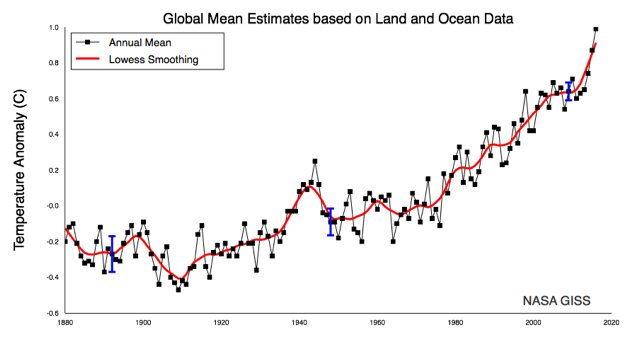
Scientists from three different agencies have announced that 2016 was the hottest year ever recorded, setting an annual temperature record for the third year in a row.
It is now thought likely that 2016 was the warmest year since the end of the last ice age, more than 10,000 years ago. Indeed the current climate records are unlikely to have been equalled since the last interglacial, known as the Eemian, about 120,000 years ago. During this time, with temperatures equivalent to those of today, sea levels were between 6 and 9 meters (20-30 feet) higher. This suggests that over the long-term, multi-meter sea level rise is now inevitable, dooming small island nations and threatening coastal areas that are home to hundreds of millions of people.
Experts from NASA, NOAA and the UK Met Office were in agreement that last year’s recorded global average temperature was 1.1 degrees Celsius (1.98 degrees Fahrenheit) above the pre-industrial baseline. The second and third-warmest years were 2015 and 2014, respectively.
This puts current global warming perilously close to the 1.5C target mentioned in the Paris agreement as a less dangerous alternative to the 2C existing international target to limit climate change. Although a strong El Nino event in the Pacific contributed to global warmth, scientists calculate its influence as limited to 0.2C.
Experts are in no doubt that the current record heat is a symptom of human-caused global warming. As Peter Stott, acting director of the UK Met Office, said: “The main contributor to warming over the last 150 years is human influence on climate from increasing greenhouse gases in the atmosphere.”
Professor Tim Osborn of the University of East Anglia’s Climatic Research Unit added: “Multiple lines of independent evidence confirm that the planet has warmed over the last 150 years: warmer oceans, warmer land, warmer lower atmosphere and melting ice. This long-term trend is the main cause for the record warmth of 2015 and 2016, surpassing all previous years even ones with strong El Ni o events in the HadCRUT4 global temperature record.”
Carbon dioxide levels, which are the main driver of increasing global temperature, are thought to be at their highest levels for many millions of years. In other words, current greenhouse gas concentrations of about 406 parts per million are higher than at any time during the recent evolutionary history of the human species. Although the rise in global carbon emissions has stalled over the last 3 years, this still means that humans pump out 10 billion tons annually from fossil fuel burning alone.
“The idea of a pause or a hiatus in global warming must now be abandoned with the announcement that 2016 was the warmest year on record,” said Mark Maslin, professor of climatology at University College London. “Climate change is one of the great challenges of the 21st century and shows no signs of slowing down. The de-carbonization of the global economy is the ultimate goal to prevent the worst effects of climate change. The hottest year on record is such a clear warning siren that even President-elect Trump cannot ignore.”
The climate change announcement comes in the same week as the inauguration of Donald Trump as President of the United States. Trump has called global warming a “hoax” and appointed several climate change deniers to head major government agencies. He has also pledged to defend the coal industry and may pull out of the Paris Agreement as well as to defund climate change science domestically and end climate assistance abroad.
For these reasons and more, Trump’s election raises concerns about an effective global response to the climate emergency. More lost years will lead to higher temperatures in future and narrows the possibility that global temperature rise will be restrained to 2C as the international community agreed at Paris. If global warming rises past that point, the likelihood of severe climate feedbacks increases, with emissions from thawing permafrost and dying forests adding still further to eventual warming.
